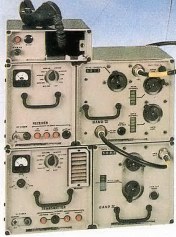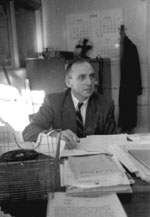Career Highlights
Hans Jakob (Jacob) von Baeyer was born 16 August 1912 (Munich, Germany), and died at age 86 on 16 September 1998 (Wakefield, Quebec).
His career, from his Ph.D. in physics at 23 to his full retirement at 79, spanned the field of telecommunications as we know it. He was a very early radio enthusiast; he became an inventor of varied sorts of telecommunications equipment; and he applied novel technology to large-scale projects such as the Mid-Canada Line. He helped launch government communications policies at the dawn of the computer age, and he became a recognized expert on satellite communications.
In every area, Dr. von Baeyer was on the leading edge of new developments. He thrived on innovation and ingenuity. When older technologies faded, he moved on. When big systems were up and running successfully, he sought new challenges. Sometimes, he worked for government, while at other times, he was active in the private sector and contributed to academia.
Dr. von Baeyer was repeatedly drawn to the search for creative solutions to uniquely Canadian problems. In the course of this work, he made significant contributions to telecommunications in Canada. For example, he brought tropospheric scatter communications technology to Canada to span great distances, especially in the North, before the advent of satellites. In his policy work, he consistently supported carefully crafted forms of cooperation between government and the telecommunications industry, as appropriate to a large country with a small market.
Dr. von Baeyer's great strength in his career was his solid basis in natural science, complemented by extensive work on the science of microwave communications. He brought to every telecommunications project a highly developed intuition in matters technical, great respect for scientific problem-solving, and a continuing attention to detail. To this he added keen foresight, never losing sight of the big picture, as well as the ability to lead diverse teams of experts. With all that, he was a modest man, and did not seek the limelight for himself.
Dr. von Baeyer's long career took him from early days in Germany and Switzerland to nearly 40 active years in Canada, including some years with the United Nations in Geneva and Athens. It was a remarkable journey.
1975-91 International Projects
![]() 1975-78 Satellite Data Transmission Expert, International Telecommunications Union, Geneva and Athens, creating the master plan for 27 countries of the Middle East and Mediterranean Telecommunication Project (later called Medarabtel)
1975-78 Satellite Data Transmission Expert, International Telecommunications Union, Geneva and Athens, creating the master plan for 27 countries of the Middle East and Mediterranean Telecommunication Project (later called Medarabtel)
1979-91 Miscellaneous consulting contracts, including advising the Korean government, and producing Telecommunications and Development (1983) for a joint project of the Canadian International Development Agency (CIDA) and the Department of Communications
1971-74 Computer/Communications Policy for Canada
![]() 1971-74 Director-General of the Canadian Computer/Communications Task Force, an independent body within the Department of Communications, producing final report called Branching Out / L'Arbre de vie, 1972, which made 39 policy recommendations in vol. I and included detailed studies of education, health care and banking in vol. II; head of the subsequent Computer/Communications Coordination Group and the Interdepartmental Computer/Communications Policy Coordinating Committee
1971-74 Director-General of the Canadian Computer/Communications Task Force, an independent body within the Department of Communications, producing final report called Branching Out / L'Arbre de vie, 1972, which made 39 policy recommendations in vol. I and included detailed studies of education, health care and banking in vol. II; head of the subsequent Computer/Communications Coordination Group and the Interdepartmental Computer/Communications Policy Coordinating Committee
1973 Named 'Telecommunications Man of the Year' by the Canadian Industrial Communications Assembly (CICA) for his organization and leadership of the Task Force
1961-71 InterTel Consultants

1961-67 President, InterTel Consultants Ltd., Ottawa, co-founded with Frederick Gall
 1961-62 Consultant on telecommunications for the Royal Commission on Government Organization (Glassco Commission), analyzing methods of message handling, as well as data and voice communications, used by federal departments, and making recommendations for major improvements (Glassco Report Vol. II, Chapter 8, Telecommunications)
1961-62 Consultant on telecommunications for the Royal Commission on Government Organization (Glassco Commission), analyzing methods of message handling, as well as data and voice communications, used by federal departments, and making recommendations for major improvements (Glassco Report Vol. II, Chapter 8, Telecommunications) 1962-65 Consultant to the Department of Defence Production on the Development Sharing Program, designing Army tactical radio relay equipment (the AN/GRC-103), and Canadian representative on the NATO Radio Relay Working Groups
1962-65 Consultant to the Department of Defence Production on the Development Sharing Program, designing Army tactical radio relay equipment (the AN/GRC-103), and Canadian representative on the NATO Radio Relay Working Groups- 1964-67 Project on Electronic Counter Measures for the Royal Canadian Navy involving an early use of computer simulation
- 1967-68 Consultant to the Interdepartmental Committee on Defence Communications, evaluating the study of this subject by CNCP Telecommunications (computer controlled store and forward message handling network)
1967-71 President, Acres InterTel Ltd., Ottawa
- 1967 Member, Association of Consulting Engineers of Canada

- 1968-69 Consultant to the Science Council of Canada on study of Scientific and Technical Information in Canada, Chairman of the Economics Subgroup that produced Part II, Chapter 7, Economics, and contributor to Part I (the Tyas Report)
- 1969 Consultant to the Canadian government on domestic communication facilities, data transmission and systems, particularly on comparisons of terrestrial versus satellite communications
- 1969 Consultant to the Interdepartmental Committee on Defence Communications, working on the integration of the governmen's defence and civilian digital communications
- 1970 Member of the Department of Communications' Telecommission teams on Northern Communications (Study 8c), and Private Systems Interconnection (Study 8bi)
- 1970 Technical Advisor to the President, Telesat Canada, during its spacecraft procurement program

1960-66 Academic Contributions
1960-64 Lecturer in the School of Engineering, Carleton University, Ottawa, at a time when the Electrical Engineering faculty was being accredited
1963-66 Theoretical contributions on digital FM transmission (note also 1949-67 technical publications on micro-wave and tropospheric scatter transmission)
1952-60 Pinetree Project and Mid-Canada Line
1952-55 Employed by Canadian Aviation Electronics Ltd. as consultant to the Pinetree Project in Ottawa, working on special microwave systems for the Arctic. Became Chief Systems Engineer, Pinetree Project Office (a joint Canada-US defence initiative), creating a UHF tropospheric scatter communications system in the sub-Arctic (called Polevault, on the northeast coast of Canada)
Link to maps showing the Pinetree Line with the Polevault communication system as well as the Mid-Canada Line and DEW Line, mid-1950s. Photo of a typical DEW Line station.
Watch Mid-Canada Radar Line Is Unveiled, a 1-minute silent newsreel, 1956.
1955-58 Chief Engineer, Systems Engineering Group, Royal Canadian Air Force (RCAF), Ottawa, creating the Mid-Canada Line, a part of the North American defence system during the Cold War designed to provide early warning of Soviet attack; the line had over 100 small stations from Labrador to Northern British Columbia 1958-60 Telecommunication Systems Engineer-in-Chief, RCAF, planning continental communications systems for Air Defence Command (SAGE), and chairman of the Common Carrier Network Planning Group for these systems
![]() 1959 Elected Fellow of the Institute of Radio Engineers, later merged into the Institute of Electrical and Electronics Engineers
1959 Elected Fellow of the Institute of Radio Engineers, later merged into the Institute of Electrical and Electronics Engineers
1935-52 Employment in Germany and Switzerland
1935-38 Telefunken Company, Berlin, Germany, patent department, working mainly on the exchange of patents with other countries
 1938-45 Telefunken Company, Berlin, Germany, television and microwave R&D lab, mainly engaged in basic development of microwave communications methods (patents received: Germany 26, France 10, US 2)
1938-45 Telefunken Company, Berlin, Germany, television and microwave R&D lab, mainly engaged in basic development of microwave communications methods (patents received: Germany 26, France 10, US 2)
[1945 Sent his wife and children to Switzerland shortly before the end of the war because his wife's mother came from a family of Jewish origin and it was no longer possible to avoid Nazi persecution; followed himself soon after]
1945-52 Brown Boveri & Co., Baden (Aargau), Switzerland, head of the microwave development group, producing radio relay communications systems for the Swiss post office and military authorities (patents received: 9)
[1952 Left Switzerland for greater opportunities in Canada]
1930-35 Education in Natural Science
1930-31 Study of medicine, University of Heidelberg
1931-35 Study of physics, chemistry and mathematics at the universities of Heidelberg, Göttingen and Vienna
 1935 Ph.D., University of Heidelberg, thesis in experimental nuclear physics on time correlations in artificial nuclear disintegration processes; left Heidelberg for the relative obscurity of Berlin after the Nazis expelled his father from his Heidelberg academic and clinical posts because he had some ancestors of Jewish origin.
1935 Ph.D., University of Heidelberg, thesis in experimental nuclear physics on time correlations in artificial nuclear disintegration processes; left Heidelberg for the relative obscurity of Berlin after the Nazis expelled his father from his Heidelberg academic and clinical posts because he had some ancestors of Jewish origin.
Family
Youngest child of Prof. Hans Emil Ritter von Baeyer 1875-1941 (professor of orthopedic surgery, Heidelberg, Germany) and Hildegard von Baeyer, née Merkel, 1882-1958; grandson of Prof. Adolf von Baeyer, Nobel laureate in chemistry, 1905
1st Marriage in 1933 to Renata von Baeyer, née Freudenberg, 1911-1977, four children
2nd Marriage in 1975 to Beverley von Baeyer, née Robinson (born 1920)
Produced in 2006 by Cornelius von Baeyer, Frederick Gall and Carl von Baeyer, with the assistance of Lars Engvall, Tjeng T. Tjhung, David Coll, Patti Harper (Carleton University Archives), Beverley von Baeyer, and Edwinna von Baeyer. Thanks to Larry Wilson for permission to copy from his website.